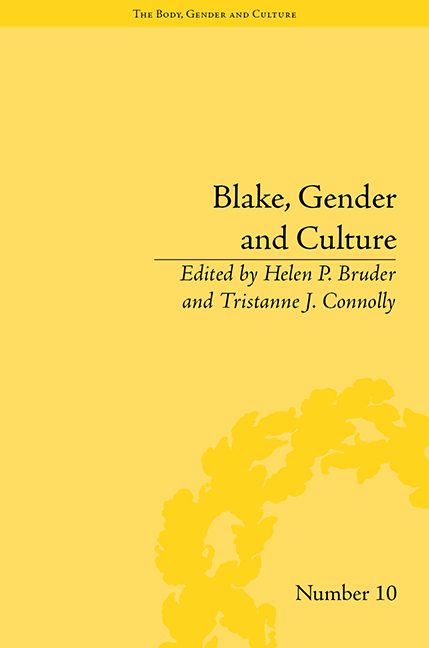Book contents
- Frontmatter
- CONTENTS
- Acknowledgements
- List of Contributors
- List of Figures
- Abbreviations
- Introduction: Naked History Displayed
- 1 ‘Merely a Superior Being’: Blake and the Creations of Eve
- 2 The Last Strumpet: Harlotry and Hermaphroditism in Blake's Rahab
- 3 Sex, Violence and the History of this World: Blake's Illustrations to the Book of Enoch
- 4 Bridal Mysticism and ‘Sifting Time’: The Lost Moravian History of Blake's Family
- 5 ‘A Secret Common to Our Blood’: The Visionary Erotic Heritage of Blake, Thomas Butts and Mary Butts
- 6 Changing the Sexual Garments: The Regeneration of Sexuality in Jerusalem
- 7 Philoprogenitive Blake
- 8 ‘Seeking Flowers to Comfort Her’: Queer Botany in Blake's Visions, Darwin's Loves and Wollstonecraft's Rights of Woman
- 9 ‘Or Wilt Thou Go Ask the Mole?’: (Con)Figuring the Feminine in Blake's Thel
- 10 Gendering the Margins of Gray: Blake, Classical Visual Culture and the Alternative Bodies of Ann Flaxman's Book
- 11 The Virgil Woodcuts Out of Scale: Blake's Gigantic, Masculine Pastoral
- 12 Closet Drama: Gender and Performance in Blake and Joanna Baillie
- Notes
- Works Cited
- Index
8 - ‘Seeking Flowers to Comfort Her’: Queer Botany in Blake's Visions, Darwin's Loves and Wollstonecraft's Rights of Woman
- Frontmatter
- CONTENTS
- Acknowledgements
- List of Contributors
- List of Figures
- Abbreviations
- Introduction: Naked History Displayed
- 1 ‘Merely a Superior Being’: Blake and the Creations of Eve
- 2 The Last Strumpet: Harlotry and Hermaphroditism in Blake's Rahab
- 3 Sex, Violence and the History of this World: Blake's Illustrations to the Book of Enoch
- 4 Bridal Mysticism and ‘Sifting Time’: The Lost Moravian History of Blake's Family
- 5 ‘A Secret Common to Our Blood’: The Visionary Erotic Heritage of Blake, Thomas Butts and Mary Butts
- 6 Changing the Sexual Garments: The Regeneration of Sexuality in Jerusalem
- 7 Philoprogenitive Blake
- 8 ‘Seeking Flowers to Comfort Her’: Queer Botany in Blake's Visions, Darwin's Loves and Wollstonecraft's Rights of Woman
- 9 ‘Or Wilt Thou Go Ask the Mole?’: (Con)Figuring the Feminine in Blake's Thel
- 10 Gendering the Margins of Gray: Blake, Classical Visual Culture and the Alternative Bodies of Ann Flaxman's Book
- 11 The Virgil Woodcuts Out of Scale: Blake's Gigantic, Masculine Pastoral
- 12 Closet Drama: Gender and Performance in Blake and Joanna Baillie
- Notes
- Works Cited
- Index
Summary
In botanical analogies such as William Blake's, plants offer an articulate perspective outside the human that can interrogate and complicate our understanding of sex and gender. In the 1790s, anthropomorphized plants enacted gender alternatives in literature, as Alan Bewell has shown, and the contentious sexuality of flowers continues to be relevant in contemporary culture. In this vein, a recent Doonesbury strip shows a gardener conversing with plants he has purchased from the ‘Georgia O'Keefe bulb nurseries’. Within the petals of ‘Magni pretii’, he reads from the greenhouse catalogue, ‘Sensuous scapes offer velvety, pink-throated blossoms … while lightly ribbed stigmata arch from the ample, flaring tubes.’ The sexual properties of the flower cups and stems (scapes) are reinforced by the flower's Latinate name, which means ‘greatly attractive’. The sexuality of the O'Keefe plants is accompanied by their ability to speak to the gardener: his friend jokes, ‘How come you're talking to your bulbs?’, and he responds, ‘There's so much to talk about.’ Indeed, gender-fluid plants such as Blake's and O'Keefe's participate in a familiar botanical discourse of diversity in sex and gender roles. In the eighteenth century, Linnaeus's sexual classification system in Species Plantarum (1753) set off a number of responses. Botany became an allegorical register for investigating options aside from traditional marriage's gendered roles. In the eighteenth century, Linnaeus's sexual classification system in Species Plantarum (1753) set off a number of responses. Botany became an allegorical register for investigating options aside from traditional marriage's gendered roles. Alongside Blake's botany in the 1790s, I consider how two authors in Joseph Johnson's circle of radical intellectuals, Erasmus Darwin and Mary Wollstonecraft, portray gender from botanically informed perspectives that suggest the naturalness of transgender and homoerotic sexualities.
- Type
- Chapter
- Information
- Blake, Gender and Culture , pp. 111 - 122Publisher: Pickering & ChattoFirst published in: 2014



